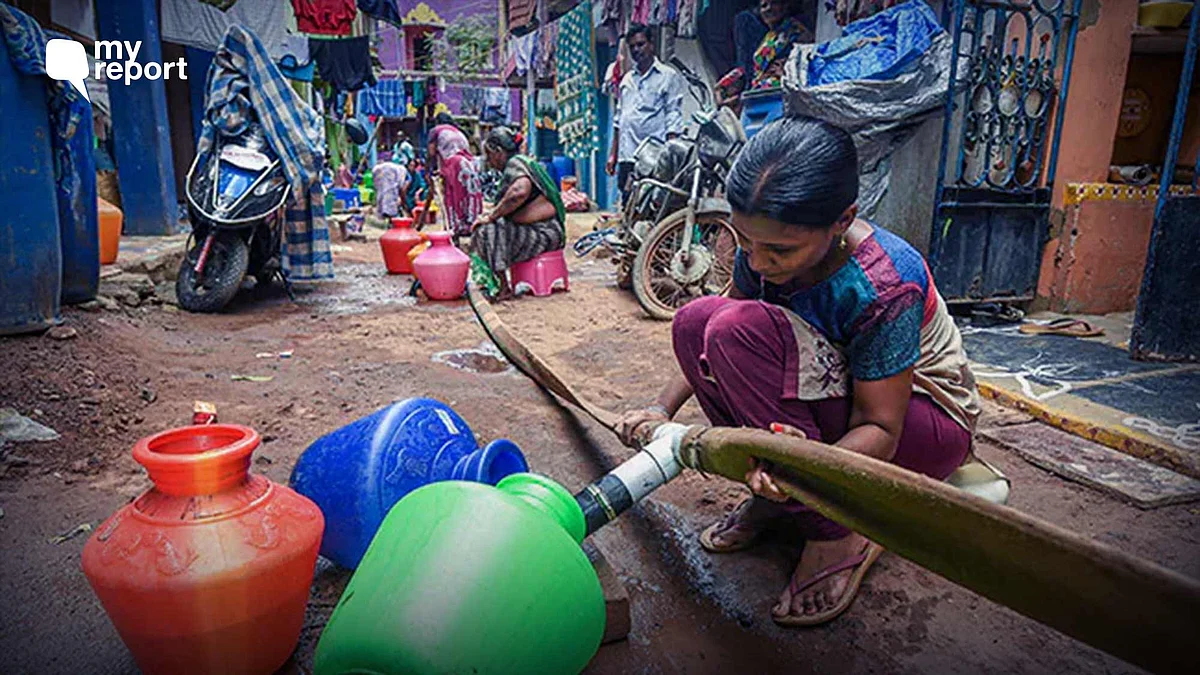
'Skip Meals to Save Money for Tankers': A Chennai Locality's Water Struggles
According to the residents, the government pipelines exist in Chennai's Indira Nagar, but they remain dry most days.

advertisement
At dawn, the street is already awake—not with the usual sounds of morning tea being poured or children getting ready for school, but with the quiet rustling of plastic pots being lined up. The queue forms long before the water tanker arrives—if it arrives at all.
Water supply is not a daily certainty for the residents of Chennai's Indira Nagar’s 16th Cross Street. It is a struggle.
Some days, the wait lasts for hours under the scorching sun. On other days, the tanker doesn’t come at all. People have learned not to expect much—just enough to get by.
Residents of Chennai's Indira Nagar queue to fill water from water tanker.
(Photo Credit: Baishnavi Sharma)
A Daily Struggle for Water
Inside a one-room house, Shanthi looks at the last bucket of water in the corner. She has to make it last at least till the next day. On 2 March, when I met her, her two children had to skip their bath. She cooked a smaller meal, just enough to keep them from going hungry.
Residents walk long distances to fill a few bottles from a friend’s home or a community hand pump.
(Photo Credit: Baishnavi Sharma)
A single spill feels like a loss. With no reliable Metro Water supply, many rely on private tankers, but prices have soared. A full tanker that once cost Rs 1,200 now sells for nearly Rs 2,500. For middle-class families, this is a burden. For daily-wage workers, it’s simply impossible.
At the end of the street, an elderly woman waits for a tanker that may not come. "I sometimes skip a meal so I can save money for water," she says. Others in the queue nod in silent agreement.
Water Measured in Buckets
Water dictates everything in Indira Nagar. Cooking and drinking come first—bathing, washing clothes, and cleaning have to wait. Dishes sit in the sink until absolutely necessary. Clothes pile up, waiting for a day when there’s just a little extra water to spare.
A full tanker of water that once cost Rs 1,200 now sells for nearly Rs 2,500.
(Photo Credit: Baishnavi Sharma)
In the evenings, as families gather outside, conversations revolve around the same question: When will the water come? No one has an answer.
Small Businesses Hit Hard
It’s not just homes that suffer—small businesses are struggling too. A tea stall owner I spoke to near the main road has had to cut down on customers. "I can’t afford to waste even a drop," he says, rinsing glasses quickly with as little water as possible.
Laundry services are in crisis. Clothes take longer to be washed, customers are fewer, and profits are shrinking.
Small eateries, dependent on water for cooking and cleaning, have reduced portions and raised prices. Even roadside juice vendors wonder if they can stay in business much longer. Water is not just about drinking and bathing—it is about survival in every sense.
As per the residents, the government pipelines exist, but they remain dry most days.
(Photo Credit: Baishnavi Sharma)
No Relief in Sight
As per the residents, the government pipelines exist, but they remain dry most days. Residents who once believed in the promise of a reliable water supply now only complain out of habit.
Even the rain offers little relief. While wealthier parts of Chennai have rainwater harvesting systems in place, Indira Nagar has no such infrastructure.
The water that could have been saved flows into the drains, lost. The tanker will come again. The pots will fill, some more than others. And then, the cycle will repeat.
In Indira Nagar, the wait for water never ends—but the thirst for dignity never fades.
(The Quint has reached out to Chennai Metropolitan Water Supply and Sewerage Board on the issue. The story would be updated as soon as they respond.)
(All 'My Report' branded stories are submitted by citizen journalists to The Quint. Though The Quint inquires into the claims/allegations from all parties before publishing, the report and the views expressed above are the citizen journalist's own. The Quint neither endorses nor is responsible for the same.)
- Access to all paywalled content on site
- Ad-free experience across The Quint
- Early previews of our Special Projects
Published: undefined